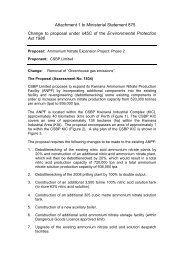Inland Waters of the Pilbara, Western Australia - Environmental ...
Inland Waters of the Pilbara, Western Australia - Environmental ...
Inland Waters of the Pilbara, Western Australia - Environmental ...
Create successful ePaper yourself
Turn your PDF publications into a flip-book with our unique Google optimized e-Paper software.
Because <strong>of</strong> <strong>the</strong> remoteness <strong>of</strong> <strong>the</strong> <strong>Pilbara</strong>, use was made <strong>of</strong> a 4-wheel drive vehicle equipped<br />
with long-range fuel tanks, spare parts and a HF radio so that repairs could be carried out<br />
and contact made with Port Hedland Royal Flying Doctor Base if emergencies arose.<br />
Sufficient provisions and fuel were carried for several weeks work away from sources <strong>of</strong><br />
supplies. As only a small amount <strong>of</strong> space was available for collecting gear and specimens,<br />
sampling <strong>of</strong> <strong>the</strong> fauna was limited. Appropriate licences to collect plants and animals were<br />
obtained from <strong>the</strong> Department <strong>of</strong> Fisheries and Wildlife<br />
During <strong>the</strong> course <strong>of</strong> <strong>the</strong> study 76 sites were surveyed. Observations were made on a number<br />
<strong>of</strong> physical and biological characteristics at each site visited. Land tenure was ascertained<br />
from cadastral maps. Field observations were recorded on an amended version <strong>of</strong><br />
Paijmans' (1978) pr<strong>of</strong>orma. This pr<strong>of</strong>orma was subsequently revised on <strong>the</strong> basis <strong>of</strong> field<br />
experience and from reference to a report on a field study <strong>of</strong> African wetlands (Morgan and<br />
Boy, 1982). The revised pr<strong>of</strong>orma (see Appendix 1) is recommended for recording field data<br />
on subsequent field studies <strong>of</strong> <strong>Pilbara</strong> inland waters.<br />
The system <strong>of</strong> springs and pools at Millstream is <strong>the</strong> best lrnown body <strong>of</strong> inland water in <strong>the</strong><br />
<strong>Pilbara</strong>. Because it has been studied in some detail (Dames and Moore, 1975). and because<br />
<strong>the</strong> importance <strong>of</strong> Millstream is recognized by its National Park status, it was not<br />
intensively sampled in <strong>the</strong> course <strong>of</strong> this study.<br />
The methods used for measuring and observing parameters are briefly outlined below.<br />
2.2 PHYSICAL CHARACTERISTICS<br />
Water temperature, conductivity, dissolved oxygen, pH and turbidity <strong>of</strong> surface waters (0-10<br />
cm depth unless stated o<strong>the</strong>rwise) were recorded with a <strong>the</strong>rmometer and a Horiba U. 7 Water<br />
Checker, Horiba Ltd Japan. Surface water permanency, water source and <strong>the</strong> relationship<br />
to groundwater were assessed where possible by direct observation and by reference to<br />
anecdotal data from local people familiar with <strong>the</strong> site. Observations <strong>of</strong> substrate types and<br />
bed gradients were also made.<br />
The area and depth <strong>of</strong> each water body were estimated and recorded for <strong>the</strong> time <strong>of</strong> sampling.<br />
Estimates were made <strong>of</strong> prior maximum flood levels from flood debris along levee banks<br />
and caught in trees.<br />
2.3 BIOLOGICAL CHARACTERISTICS<br />
The dominant floral and characteristic fauna! associations <strong>of</strong> different wetland types were<br />
examined to obtain base-line data useful in <strong>the</strong> formulation <strong>of</strong> a suitable classification<br />
system for <strong>the</strong> surface waters <strong>of</strong> <strong>the</strong> <strong>Pilbara</strong> region.<br />
(i) Fringing vegetation - The fringing vegetation was sampled along a transect from <strong>the</strong><br />
land/water interface to a point designated as <strong>the</strong> limit <strong>of</strong>wetland influence (eg top <strong>of</strong> a levee<br />
bank) and recording apparent zonation patterns. Plant specimens were collected, pressed<br />
and dried in <strong>the</strong> field, and mounted on herbarium sheets (<strong>of</strong>ten more than one specim~n per<br />
sheet due to space limitations) for later identification.<br />
Preliminary identifications were made in <strong>the</strong> field and at Karratha with <strong>the</strong> assistance <strong>of</strong> W<br />
Edgecombe and P Ryan from <strong>the</strong> Forests Department. Identifications were verified by M E<br />
Trudgen using <strong>the</strong> facilities <strong>of</strong> <strong>the</strong> W A Herbarium. Specimens will be mounted and used as<br />
aids for plant identification during future studies in <strong>the</strong> region.<br />
(11) Aquatic vegetation - The emergent and submerged aquatic macrophytes were<br />
sampled and zonations recorded. Specimens were collected and treated similarly to those <strong>of</strong><br />
fringing vegetation. The more delicate submerged plants were preserved in 10% formalin.<br />
(iii) Phytoplankton - Phytoplankton was sampled to determine concentration and<br />
major genera present. A known quantity <strong>of</strong> sample water, up to I L, was filtered through a<br />
Whatman 2.5 cm D GF /C filter. The filter was airdried and stored in <strong>the</strong> dark for subsequent<br />
determination <strong>of</strong> <strong>the</strong> major chlorophyll concentrations by <strong>the</strong> trichromatic method<br />
(Strickland and Parsons, 1972). A 5 ml water sample was also passed through a Metrical<br />
4



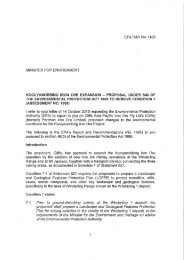
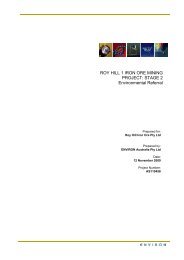

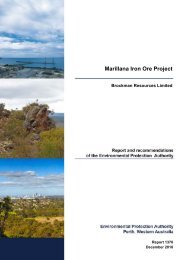
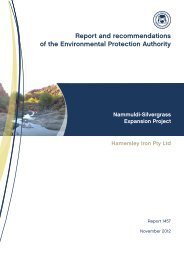
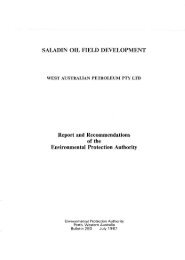
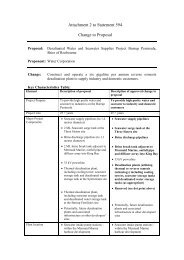
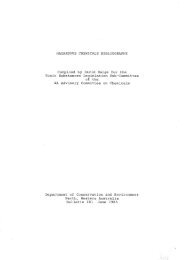
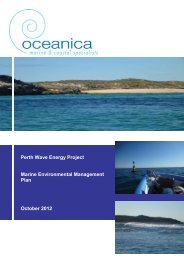
![[Project Title] - Environmental Protection Authority](https://img.yumpu.com/35475857/1/184x260/project-title-environmental-protection-authority.jpg?quality=85)

![[Project Title] - Environmental Protection Authority](https://img.yumpu.com/33147681/1/184x260/project-title-environmental-protection-authority.jpg?quality=85)
